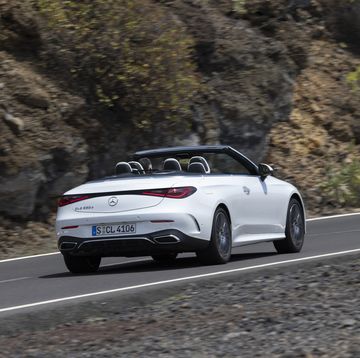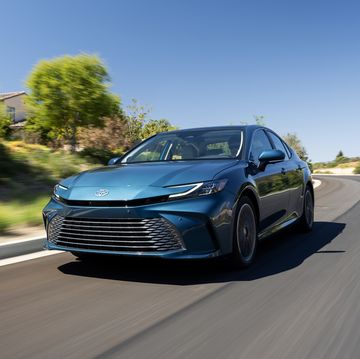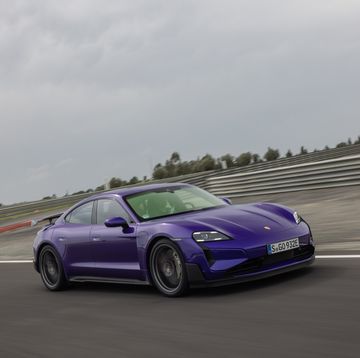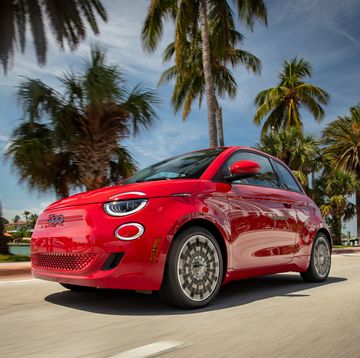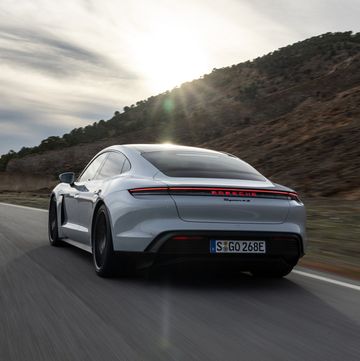There's a fairly long straightaway on the handling course at Mazda's Miyoshi proving ground that encourages a bit of leg stretching, but the sweeping left-hander that leads to it is blind because of hedges that surround much of the track.
Luckily, the corner has broad paved shoulders so we could take a long, wide line, letting the new RX-8 drift comfortably across the track as it barreled onto the straight. Then it was just a matter of burying the throttle and watching the digital speedometer wink upward through the numbers, reaching 190 kilometers per hour (about 119 mph) before running out of racetrack.
As the speed creeps up, so does the intensity of the sound, changing from a flat ripping note to an angry drone as it reaches for its 8500-rpm power peak. An almost indiscernible vibration at the controls grows to a subtle trembling, as if the car were firing an ultra-light-recoil machine gun. The experience is unlike anything else.
This, then, is the return of the rotary. For a while there we thought green zealotry had killed off the only viable gas-burning alternative to the ubiquitous reciprocating engine. But a brilliantly straightforward modification to the rotary engine's design has improved fuel economy by 20 percent, according to Seiji Tashima, the engineer in charge of the so-called Renesis engine project, and cleaned up emissions so they meet LEV II and Euro 4 standards.
Mazda engineers simply moved the exhaust ports (there are no valves in a rotary engine) from where they had been on the peripheral face of the rotor housing and placed them on the side plates. At a stroke, that reduced the overlap between inlet and exhaust ports, minimizing the amount of air-fuel mixture lost directly out of the exhaust port.
In turn, this modification yielded lower fuel consumption and produced cleaner exhaust emissions. In the process Mazda made the naturally aspirated 13B twin-rotor Renesis engine about as powerful (at a provisional 247 horsepower) as the previous-generation turbo motor. One of the tweaks is a 30-percent increase in port size. Other additions are a variable-volume intake system and an electronic throttle. The rest is Mazda magic.
But before you start mentally calculating how much more power a turbo version of the Renesis engine will punch out, we have to tell you that relatively cool exhaust gas from turbocharged rotary motors prevents efficient catalytic conversion, making it unlikely we'll see one soon, if ever.
But never say never. Hey, they brought back the rotary, didn't they? And in this new RX-8, it embodies an unusual concept: the four-seat sports car. Yeah, we know that Nissan once called the Maxima a four-door sports car, but let's get real here. This RX-8 actually runs and steers and feels like a convincing spiritual successor to the quick-witted but slow-selling RX-7.
It's easy to say four-seat sports car, but what does it mean? In this case, it means feeling light and nimble, turning in like a race car, and resisting roll in corners. It means splitting its mass 50/50 over the front and rear axles and crouching on an independent suspension all around, with rear toe-control links to keep the tail from wagging the dog. (A stability-control function is now included for the faint of heart.) It means rear-wheel drive, a slick six-speed shifter, and a warning buzz when the roaring rotary hits nine grand.
But this time you can take three passengers along for the ride, thanks to a pair of rearward opening "freestyle doors" that allow access to a surprisingly spacious rear compartment. Because the front and rear doors marry without a center pillar, the two rear seats can be reached fairly easily through the large apertures. And since there are no external handles on the rear doors, the sports-car image isn't compromised by four protrusions. A system of interlocking lateral and vertical beams forms a tough skeleton inside the door skins to provide decent side-impact protection. In the process, they also lend the interlaced doors a great deal of rigidity.
The lack of a center pillar helps keep the wheelbase relatively short. According to Mazda's engineers and stylists, a center pillar would have added almost six inches to the car's length. At a comparatively short 174.6 inches, the RX-8 is exactly the same length as a Honda Civic four-door.
Despite its enlarged passenger cabin, the RX-8 is claimed to be twice as stiff in torsion and 1.7 times more resistant to bending than was the last-generation RX-7. After looking at the sturdy bridge that connects the gearbox and differential unit and the robust shock-tower braces front and rear, not to mention two underfloor tunnel braces, we can believe it.
Besides, the unibody itself has beefy front frame rails that divide to join a backbone frame in the center and longitudinal rails on the sides. This system was designed to transfer crash loads while collapsing in a programmed fashion. To further protect occupants, a roof gusset and floor crossmembers form a cage around the passenger compartment. All these features helped the RX-8 ace federal and Japanese new-car assessment program tests with maximum scores.
The RX-8 also has a framework of high-tensile longitudinal rails and crossmembers in its tail to anticipate a pending 50-mph offset rear crash-impact test. Despite all this reinforcement and buttressing, the RX-8 is expected to weigh just over 3000 pounds.
Along with the high-powered six-speed model we will see here as a flagship in the spring of '03, there will be a lower-powered (about 207 horsepower) version with a five-speed automatic transmission. A sport suspension will be offered as an option on either model, with 18-inch wheels and 45R-18 Bridgestone Potenza RE040 tires replacing the standard 16-inch wheels and R-16 tires.
Thirteen-inch front brake rotors are also to be an option over the stock 12-inch units. The car will come with Tokico monotube shocks and Bosch-supplied ABS and stability control as standard equipment. Steering assist is by electric motor, and the interior is clad in three contrasting molded textures with optional color leather inserts on the seats and steering wheel. The audio panel mimics a high-end CD player, and triangular rotor motifs abound. And the price? At an expected base of $27,000, the RX-8's value harks back to the early days of the RX-7.
Finally, for those utility addicts, there are cup holders fore and aft, and the trunk will hold two golf bags or two medium Samsonite suitcases. All of which begs the question: Is a four-seat sports car an oxymoron?
Wait and see.




